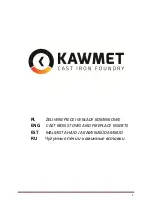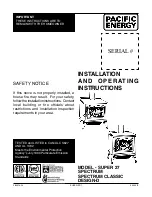
9
®
OPERATING INSTRUCTIONS
the installer will have provided alternative means, such as a soot
door. After sweeping the chimney the appliance flue outlet and the
flue pipe connecting the stove to the chimney must be cleaned with
a flue brush.
After clearing any soot from within the stove, replace the throat
plate (see Fig. 5 ) and the fuel retainer.
Different types of sweep’s brushes are available to suit different
flueways. For prefabricated insulated chimneys the manufacturers
instructions with regard to sweeping should be consulted.
TROUBLE SHOOTING
Fire Will Not Burn
Check that:
a) the air inlet is not obstructed in any way,
b) chimneys and flueways are clear,
c) a suitable fuel is being used,
d) there is an adequate air supply into the room,
e) If an extractor fan is fitted, that it is not causing lack of flue draft
when operating.
f) there is sufficient draw in the chimney. Once the chimney is warm
a draught reading of at least 1.25 mm (0.05 in.) water gauge (12Pa)
should be obtained.
Blackening of Door Glass
Differences in chimney draughts mean that the best settings of the
air controls will vary for different installations. A certain amount of
experimentation may be required, however the following points
should be noted and with a little care should enable the glass to be
kept clean in most situations:
a) Wet or unseasoned wood, or logs overhanging the front fence will
cause the glass to blacken.
b) The airwash relies on a supply of heated air to keep the glass clean,
therefore, when lighting the stove allow the firebed to become well
established before closing the air control. This may also be necessary
when re-fuelling the stove.
c) When re-fuelling keep the fuel as far back from the front fence as
possible, do not try to fit too much fuel into the firebox.
d) Do not completely close the air control.
It is always more difficult to keep the glass clean when running the
stove very slowly for long periods.
If blackening of the glass still occurs check that all flue connections
and the blanking plate are well sealed. It is also important that the
chimney draw is sufficient and that it is not affected by down-draught.
When the chimney is warm a draught reading of at least 1.25 mm
(0.05 in.) water gauge (12Pa) should be obtained. Some blackening
of the glass may occur below the level of the fuel retainer. This will
not obscure the view of the fire or affect its performance.
Fume Emission
Warning Note: Properly installed and operated this appliance will
not emit fumes. Occasional fumes from de-ashing and re-fuelling
may occur. Persistent fume emission is potentially dangerous and
must not be tolerated. If fume emission does persist, then the
following immediate actions should be taken:
a) Open doors and windows to ventilate the room and then leave
the premises.
b) Let the fire out and safely dispose of the fuel from the appliance.
c) Check for flue or chimney blockage, and clean if required.
d) Do not attempt to re-light the fire until cause of fuming has
been identified, if necessary seek professional advice.
The most common cause of fume emission is flueway or chimney
blockage. For your own safety these must be kept clean.
Fire blazing out of control
Check that:
a) The door is tightly closed.
b) The air control slider is fully closed.
c) A suitable fuel is being used.
d) Door seals and airwash slide are intact.
Chimney Fires
If the chimney is thoroughly and regularly swept, chimney fires
should not occur. However, if a chimney fire does occur close the air
control, and tightly close the door of the appliance. This should cause
the chimney fire to go out in which case the controls should be kept
closed until the stove has gone out. The chimney and flueways should
then be cleaned. If the chimney fire does not go out when the above
action is taken then the fire brigade should be called immediately.
After a chimney fire the chimney should be carefully examined for
any damage. Expert advice should be sought if necessary.
CO ALARM
Your installer should have fitted a CO alarm in the same room as the
Summary of Contents for ISLAND I-AP
Page 1: ... Operating Installation Instructions ...
Page 2: ......
Page 21: ......
Page 22: ......
Page 23: ......
Page 24: ...your premier dealer ...










































